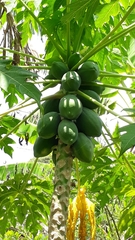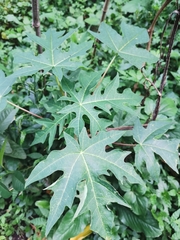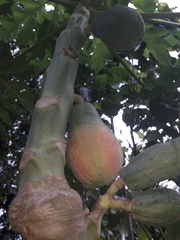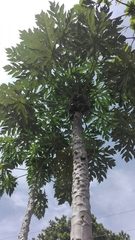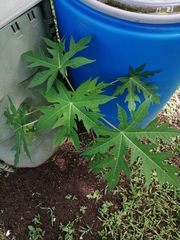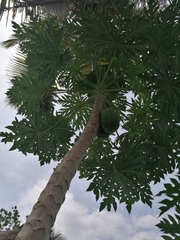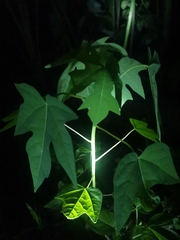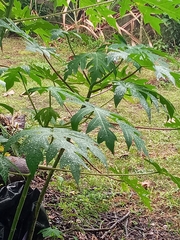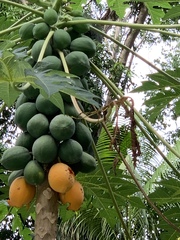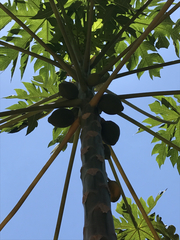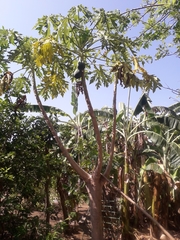

|
|
|
|
Family: Caricaceae
Papaya, more... (es: Papaya)
|
Descripción: Árboles o arbustos de 5-10 m de alto. Tronco usualmente no ramificado y hueco. El desprendimiento de cualquier parte de la planta produce una savia lechosa. Hojas concentradas en la parte apical del tronco, alcanzan hasta 70 cm de diámetro, palmatilobuladas, los lóbulos enteros o profundamente lobulados y con ápices agudos. Pecíolo de 60-80 cm de largo. Flores blancas, unisexuales o bisexuales. El fruto es alargado o esférico, a menudo presenta cinco surcos poco pronunciados, mide entre 10-60 cm de largo, verde, tornándose amarillo o anaranjado según la variedad. La pulpa jugosa del fruto rodea una porción hueca que contiene numerosas semillas. Datos Ecológicos: La papaya es originaria de México y América Central, pero fue distribuida por los españoles a otros países tropicales. Hoy día se cultiva como frutal en África, India, Malasia, Filipinas, Hawái, Brasil y Florida. En Panamá se encuentra como planta cultivada en todo el territorio nacional. Florece y fructifica durante todo el año. Especies Parecidas: A menudo se confunde con LK carica Vasconcellea cauliflora LK2 , pero en V. cauliflora el fruto es más pequeño y solitario. Usos: La pulpa de los frutos maduros es comestible, rica en vitamina A y C. Se utiliza para hacer jugos, batidos, helados y mermeladas. Con la pulpa de los frutos verdes y miel de caña se hace un dulce muy popular, conocido como ‘cabanga’. Las hojas se utilizan para ablandar la carne. La savia lechosa contiene un principio activo conocido como papaína, que se utiliza en preparaciones farmacéuticas. Unbranched tree, mostly to 6 m tall, essentially glabrous, dioecious or rarely polygamous or monoecious. Leaves in a dense terminal crown; petioles to 70 cm long; blades ovate, deeply 5-9-lobed, cordate at base, the lobes broadly pinnatifid when mature, 20-40 cm long, obscurely acuminate; palmate veins at base 7-9. Staminate inflorescences axillary; flowers many, short-pedicellate, ca 2 cm long; sepals 5, ca 1 mm long, green; corolla cream-yellow, the tube slender, the limb 5-lobed, the lobes oblong; stamens in 2 series, ca 2.5 mm long. Pistillate inflorescences of 1-3 flowers on pedicels to 2.5 cm long; calyx lobes ca 1 mm long, green; corolla 5-lobed to base, 5-7 cm long, cream-yellow; style to 1 cm long; stigmas 5, usually with 1 or 2 short branches. Fruits maturing within crown of leaves; berries variable. Croat 5907. Cultivated at the Laboratory Clearing. Flowers sporadically year-round. Sex changes in the flowers are reported under different ecological conditions (Percival, 1965). Bocas Species Database Habitat: Papaya is grown in the tropics and in the subtropics where there is no frost. It can grow up to an elevation of around 1500 m and at optimum temperatures between 25°C and 38 °C. In order to obtain high quality fruits, rich in sugar content, papaya trees need full sunlight. The tree also needs an annual rainfall between 1,000 and 2,000 mm. It also needs to be protected by strong winds because it does not have a very resistant wood. Therefore, other trees or structures are installed around papaya orchards to serve as windbreaks. Papaya also needs a fairly good soil, rich in organic matter and with a fairly neutral pH and a well irrigated soil. Distribution: The papaya tree is native to the tropical America. Papaya is now grown in all tropical and sub-tropical countries in the world. Natural History Notes: Papaya represents an ideal fruit to commercialize because of its fast rate of growth and development and its high potential yield. The tree is usually multiplied by seeds and the seeds will be planted at the beginning of the raining season. When a papaya tree starts producing flowers and fruits, its best condition will last for two or three years and although the tree could still produce fruits, its economic life will comes to an end when the fruits are hanging so high that they cannot be collected profitably. A fruit can mature in 4 -6 months and will be picked up by hand or with the help of machines, depending on the region and the importance of the orchard. Characteristics: Papaya belongs to the family Caricaceae and is the only species with an economic importance within this family. The papaya is a perennial small tree with soft wood and a fast rate of growth, making people believe that papaya is in fact a plant. The trunk is usually unbranched and can reach a height from 5-10 m and a diameter of 25 cm. The leaves show a spiral arrangement and are located at the top of the stem. The stem is usually unbranched. The leaves have a cylindrical shape and the leaf blade (edge) has 7 to 11 main lobes and some smaller secondary lobes that are more pointed. The leaves have a coloration that varies from yellow-green to dark-green on the above. Then, the male flower and the female flowers are present on separate plants, but it is pretty commune to find hermaphrodite flowers. The hermaphrodite flowers will tend to become what we call “carpelloid”, (fruit-like) which cannot be used on the market. The flowers usually emerge singly or in clusters. They have a creamy white coloration and are fragrant. The fruit can vary in shape and in size, but generally it will have a long oval-elongated shape with a size range between 10 cm and 60 cm. The skin of the fruit is yellow but becomes more orange as it is ripe. The inside of the fruit is composed of an orange-reddish flesh that has a sweet and kind of musky taste. In the center of the fruit, there is a cavity full of black, small seeds. Notes: Papaya is one of the most popular fruits in the tropics and is now sold regularly on markets of northern countries. Beside its interesting flavorful taste and texture, the papaya possesses several nutritional qualities. It is an important source of vitamins A, B and C, and contains a mild laxative action that facilitates its digestion. In some countries, the unripe fruit can be fermented or cooked to serve as a substitute for apple sauce. The ripe fruit is part of the daily diet of many people in the tropics. For breakfast, papaya is blended with milk and served as a “batido”. Papaya is also eaten in salads or in desserts and is also used to make jams. The papaya tree and the unripe fruit both contain latex that is rich in two enzymes, papain and protease, which are used as a tenderizer for meat and for medical purposes. The black seeds are also edible and have a spicy taste and they are sometimes used as a substitute for pepper. |



